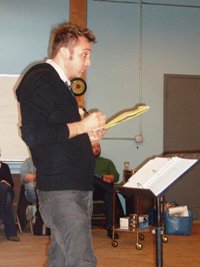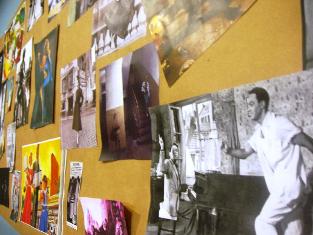The Marriage of Figaro Article
Rehearsal Room for Berry’s Retro Figaro
by Kelli Marino
 Pictured: Director Jonathan Berry |
With laughter constantly coming from inside The Marriage of Figaro‘s rehearsal room, the Remy Bumppo staff on the other side of the wall wonders “how much rehearsing is actually going on?” Today, I am able to answer that question, and much to our surprise, there is a lot of rehearsing going on. I sat in on rehearsal to get a better understanding of how director Jonathan Berry is going to take an 18th century French farce by Beaumarchais and translate it first into his 1950s concept, and then make it relevant to contemporary audiences.
Beaumarchais’ 18th century play, The Marriage of Figaro was written in a time of great political upheaval, overturning classes, and the dawn of the French Revolution. Beaumarchais wrote plays about the court, from within the court, therefore his true messages had to be veiled. His political arguments, though, about lower classes striving for freedom and women breaking from traditional roles, are not easy to miss. Berry’s new production of Ranjit Bolt’s adaptation, strongly speaks to a contemporary and political audience just like Beaumarchais’, but in a distant era. Berry sets his production in 1950s France, a gilded mirror to the age of Beaumarchais.
In post World War II France, female gender politics began to lose its “Rosie the Riveter” momentum. Christian Dior’s “new look” emphasized returning the female silhouette to a “traditional” shape, and thus returning women to a traditional role. The production’s 1950s concept is “about finding the parallel between the coming rebuke of the 1780s class system and the struggle that was felt in France in the early 1950s between the death of French colonialism and the divide between the right-wing conservatives and the growing communist party,” says Berry. “After the war, everyone was pushed back into their more traditional gender and class roles; this production is invested in the tension created by that push.”
 Pictured: Marriage of Figaro rehearsal room |
The rehearsal room is decorated with inspiration pictures of 1950s families in their traditional roles, women from the 1950s oozing sex appeal, but in a beautiful and classy way, and figures of dancers and ballerinas juxtaposed with elephants. Berry also encourages the actors to push the size and style of the piece, so that they “may land the journey for understandable reality. This is a heightened style, with a natural feel.” He then jokingly asks if that makes the play make anymore sense.
What really captured my attention during the rehearsal was Berry himself. He never sat down. He stands at his music stand with script and note pad in hand, actively participating in the process. Berry literally jumps at the notion of an actor saying that something inspired them. He is very physical, and actually embodies the French era in which Figaro was written. For theatre goers who know the commedia dell’arte or comedy of manners style, his fourth position stance is typical of the Scapino or servant characters. Yet his inability to stand still brings great energy to the rehearsal room, and hence his actors. I can see his manner in the characters’ movements and actions. Most endearingly, Berry laughs and shakes his head as he looks at his notes. His love and delight in directing Figaro shines thorough as he refuses to take himself too seriously.
Artistic Director James Bohnen picked Berry to direct Figaro because of the heartfelt choices and informed precision in Berry’s other works, which is at the heart of Remy Bumppo’s productions. With a quick jaunt to France, where farce reigns supreme, Remy Bumppo wants to stretch the boundaries of our approach to English and American plays with brilliant language, for one with an additional physical manifestation of the language. “French farce can easily be dismissed,” says Berry, “but what grounds The Marriage of Figaro is the political argument.” And as America knows, we need more political arguments!
